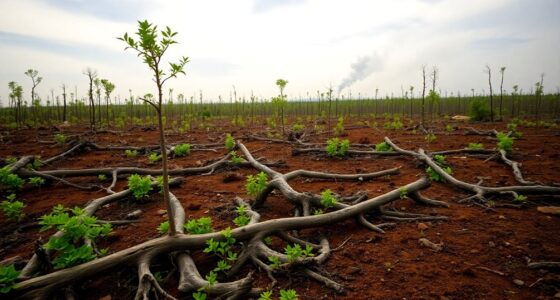Balancing the need to protect natural ecosystems with the demands of human development is a challenge many face today. As communities grow and economies expand, the pressure to convert green spaces into urban or industrial zones increases. This often leads to conflicts between conserving biodiversity and meeting human needs. Understanding how these competing interests can coexist might be key to creating sustainable solutions that serve both nature and people—yet, navigating these complexities isn’t straightforward.
The Growing Conflict Between Natural Preservation and Urban Expansion
As cities expand to accommodate growing populations, the conflict between preserving natural habitats and pursuing urban development becomes more intense. You see this every day as new neighborhoods, roads, and commercial areas take over green spaces.
Developers push for land use that boosts economic growth, while conservationists fight to protect ecosystems and biodiversity. This clash often leads to the destruction of forests, wetlands, and parks, threatening wildlife and reducing natural buffers against climate change.
You might notice that urban sprawl spreads into rural areas, fragmenting habitats and disrupting migration patterns. Balancing these competing interests is challenging, especially as demand for housing, infrastructure, and resources continues to grow.
The struggle underscores a fundamental dilemma: how to meet human needs without sacrificing the environment. Recognizing the importance of natural buffers and their role in climate regulation can help guide sustainable development efforts.
Economic Growth Versus Ecosystem Health: Finding Common Ground
Balancing economic growth with the health of ecosystems requires innovative approaches that benefit both development and the environment. You can explore sustainable practices like green infrastructure, renewable energy, and eco-friendly agriculture, which promote growth without damaging natural resources.
Implementing policies that incentivize companies to reduce their ecological footprint encourages responsible business practices. You might also support community-led conservation efforts that create economic opportunities while preserving biodiversity.
Investing in green technology can stimulate job creation while maintaining ecosystem integrity. Collaboration between policymakers, businesses, and local communities is essential to find solutions that align economic interests with environmental health.
When you prioritize sustainable development, you help ensure that economic progress doesn’t come at the expense of nature’s resilience and long-term vitality. Relationships can play a vital role in fostering community engagement and promoting collective responsibility for conservation efforts.
Impact of Infrastructure Projects on Biodiversity Hotspots
Infrastructure projects often threaten biodiversity hotspots, which are areas rich in endemic species and ecological significance. When you build roads, dams, or urban developments in these regions, you fragment habitats and disrupt vital ecological processes.
This can lead to the loss of rare plants and animals that have nowhere else to go. Construction noise, pollution, and land clearing directly harm wildlife, while altered water flows can damage delicate ecosystems.
You might also unintentionally introduce invasive species that outcompete native ones. These projects often prioritize immediate human needs over long-term ecological health, risking irreversible damage to these critical zones.
Protecting biodiversity hotspots requires careful planning to minimize habitat destruction and ensure that development doesn’t come at the expense of nature’s most vulnerable and valuable areas.
The Role of Policy and Legislation in Balancing Development and Conservation
Policy and legislation play a crucial role in ensuring that development proceeds without sacrificing the health of our ecosystems. They set the legal framework that guides responsible land use, resource extraction, and urban planning.
Strong laws can protect critical habitats, establish protected areas, and regulate activities that threaten biodiversity. Effective policies also incentivize sustainable practices, such as renewable energy or conservation-friendly agriculture.
You can influence this balance by advocating for policies that prioritize environmental health alongside economic growth. Governments can enforce penalties for illegal activities like poaching or deforestation, ensuring accountability.
Ultimately, well-crafted legislation aligns development goals with ecological preservation, helping you support initiatives that foster sustainable growth while safeguarding nature for future generations.
Community Involvement and Sustainable Land Use Practices
Community involvement is essential for promoting sustainable land use practices that protect the environment while supporting local needs. When you actively participate in decision-making, you help ensure that development respects ecological limits and community well-being. Engaging local residents, farmers, and businesses creates a sense of ownership and responsibility, making conservation efforts more effective. Your input can influence land-use planning, encouraging practices like crop rotation, reforestation, or preserving green spaces. Education and awareness campaigns empower you to make eco-friendly choices daily. Collaboration with local authorities and conservation groups fosters innovative solutions that balance growth with preservation. Understanding architectural needs can help integrate sustainable design principles into land use planning, ensuring development aligns with ecological and community goals.
Innovative Technologies Bridging the Gap Between Nature and Progress
Advancements in technology are opening new pathways to harmonize development with environmental conservation. You can now use tools like drone surveillance to monitor ecosystems without disturbing wildlife. Satellite imaging helps you track deforestation and habitat changes in real-time, allowing for quicker responses. Incorporating Kia Tuning options into vehicles can also promote more efficient driving habits, reducing emissions and lowering environmental impact.
Artificial intelligence analyzes data to identify areas at risk, guiding targeted conservation efforts. Eco-friendly building materials and green infrastructure innovations reduce environmental footprints in urban development. Renewable energy technologies, like solar and wind, enable communities to grow sustainably.
Smart sensors in forests and waterways provide ongoing insights into ecological health. These innovations empower you to balance progress with preservation, reducing conflicts and fostering coexistence between human needs and nature. Embracing these technologies paves the way for smarter, more sustainable development.
Case Studies of Successful Integrations of Conservation and Development
One compelling example of successful integration is Costa Rica’s reforestation program, which balances ecological preservation with economic growth. You’ll see how the government incentivized landowners to restore forests through payments for ecosystem services, creating a financial reward for conservation efforts. This approach helped reforest degraded lands, boosting biodiversity and improving water quality. Meanwhile, eco-tourism flourished, generating jobs and income for local communities. Additionally, employing high-quality projectors in eco-tourism sites can enhance visitor experiences and promote conservation awareness. By aligning environmental goals with economic incentives, Costa Rica showed that conservation can be part of sustainable development. This model encourages other nations to adopt similar strategies, proving that protecting nature and fostering economic progress can go hand in hand. The country’s experience demonstrates that innovative policies and community engagement lead to lasting success.
Challenges of Resource Extraction and Habitat Preservation
While Costa Rica’s reforestation efforts show that conservation and development can work together, resource extraction often presents significant hurdles to preserving habitats.
When you extract minerals, timber, or fossil fuels, you risk destroying ecosystems that took years to develop. Mining and logging can lead to deforestation, soil erosion, and water pollution, threatening countless species.
Indigenous communities and local residents might depend on these habitats for their livelihoods, making the conflict even more complex.
You may face tough choices: prioritize immediate economic gains or protect long-term ecological health. Balancing these needs requires careful planning, strict regulations, and sustainable practices.
Without such measures, the drive for resource extraction can undo years of conservation work, leading to irreversible damage in fragile ecosystems.
Future Perspectives: Building a Harmonious Relationship Between Humans and Nature
As we look to the future, building a harmonious relationship between humans and nature requires intentional effort and innovative thinking. You can start by adopting sustainable practices in everyday life, such as reducing waste, conserving energy, and supporting eco-friendly policies.
Embracing new technologies like renewable energy and smart agriculture can minimize environmental impact while meeting human needs. Education plays a critical role; spreading awareness about ecological balance encourages responsible behavior.
Collaboration between governments, communities, and businesses is essential to develop solutions that prioritize both conservation and development. Recognizing the importance of sustainable land use planning can help prevent conflicts between development projects and natural preservation efforts.
By valuing nature’s intrinsic worth and recognizing its importance for future generations, you help foster a culture of respect and stewardship.
Together, these efforts can create a sustainable future where humans coexist peacefully with the natural world.
Conclusion
Balancing conservation and development isn’t easy, but it’s essential for a sustainable future. By engaging communities, leveraging innovative technologies, and crafting strong policies, you can help create solutions that protect nature while supporting growth. Remember, thoughtful planning and collaboration allow you to meet human needs without sacrificing ecosystems. Together, you can build a world where progress and preservation go hand in hand, ensuring a healthier planet for generations to come.






